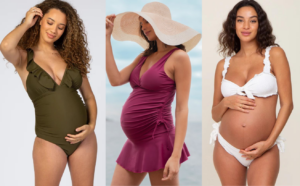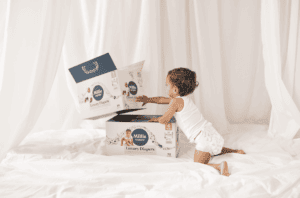When we become parents, we begin teaching our babies by reading, talking, and playing with them. As a Pediatric Occupational Therapist, I know that sensory play is one of the most beneficial forms of play for kids of all ages. It often occurs naturally during open-ended play. Sometimes, it can be challenging for parents to recognize what sensory play is and how it benefits their child’s development. Chances are your child is already engaging in one form of sensory play or another. Still, this article will help you understand what sensory play is, why it’s essential, and what sensory toys and products are our favorites for babies, toddlers, and older kids.
As kids play and explore their environment, their brains help them make sense of and understand the people and objects within that environment. Sensory play is beneficial for engaging your child’s senses and incorporating other skills, such as fine and gross motor development, language development, and social-emotional attachment. Certain types of sensory play can also have a calming effect on kids, and you can help with this by giving them appropriate sensory toys for them to play with. We’ve compiled a list of the best sensory toys and products for babies, toddlers, and older kids.
What Is Sensory Play?
At its most basic form, sensory play is a type of play that engages your child’s senses. Most people think we have five senses – sight, smell, taste, sound, and touch. But additional senses are essential for your child’s understanding of the world. The vestibular system helps us understand movement, acceleration, and our head position. This system helps us know when a car is slowing down or accelerating, recognize whether an elevator is going up or down, and helps our sense of balance. The proprioceptive system helps us understand our relative body position and force. This system is responsible for helping us apply the right amount of pressure when writing with a pencil vs. a crayon, and proprioceptive input helps us touch our finger to our nose with our eyes closed.1
The Best Sensory Toys and Products for Babies, Toddlers, and Kids
We’ve broken up the best sensory toys and products for kids into categories for babies, toddlers, and kids.
10 Best Sensory Toys for Babies
1. Water Mat

Tummy time is essential for developing head and neck control, shoulder stability, and core strength. These impact a baby’s ability to roll over and eventually start crawling. And when babies are very young, their vision is still developing, so having toys close in view is essential. This water mat is an excellent mess-free sensory activity and will keep your baby engaged on the floor for longer periods for more tummy time exploring! When it’s not filled, it’s nice and compact for storage or travel.
2. Wrist and Sock Rattles

When babies are young, they cannot grasp toys and shake them. These toys are perfect for those early days. The soft wristbands can wrap around a baby’s wrist, and the socks are ideal for tiny feet. Your baby will love to shake their arms and legs to make the rattles shake. This is one of the earliest activities for babies to learn cause and effect. It’s also beneficial for body awareness and helping your baby understand their body parts.
3. Spinning Stacking Rings

Stacking rings are a classic toy, and I’ve always loved this “spin” on the original concept. This stacker features six double-sided gears that spin onto the pole as they drop. At this age, babies are really starting to understand the concept of cause and effect and are working on their fine motor skills. This toy is excellent for both of these areas and visual motor coordination. At the start, you will need to help your baby place the gears onto the pole, but eventually, your baby will learn how to do it independently and play with it repeatedly!
4. Chew Cube

Babies love exploring toys with their mouths. Whether they’re teething or playing, I can say with some certainty that babies will put toys in their mouths, so we must provide them with safe options for play. This toy is a modern take on a classic teether. It was created by a mom and made of 100% food-grade silicone. Its flexible, textured edges will soothe babies’ sore teething gums, and the size and shape allow your baby’s hands to grip easily.
5. Stacking Soft Blocks

Blocks are an excellent toy for any child. This four-block set is perfect for little hands to discover and explore. Each features multi-textured fabric for tactile stimulation and vibrant colors your baby will love. They also feature rattle sounds to stimulate a baby’s sense of sound.
6. Textured Ball Set
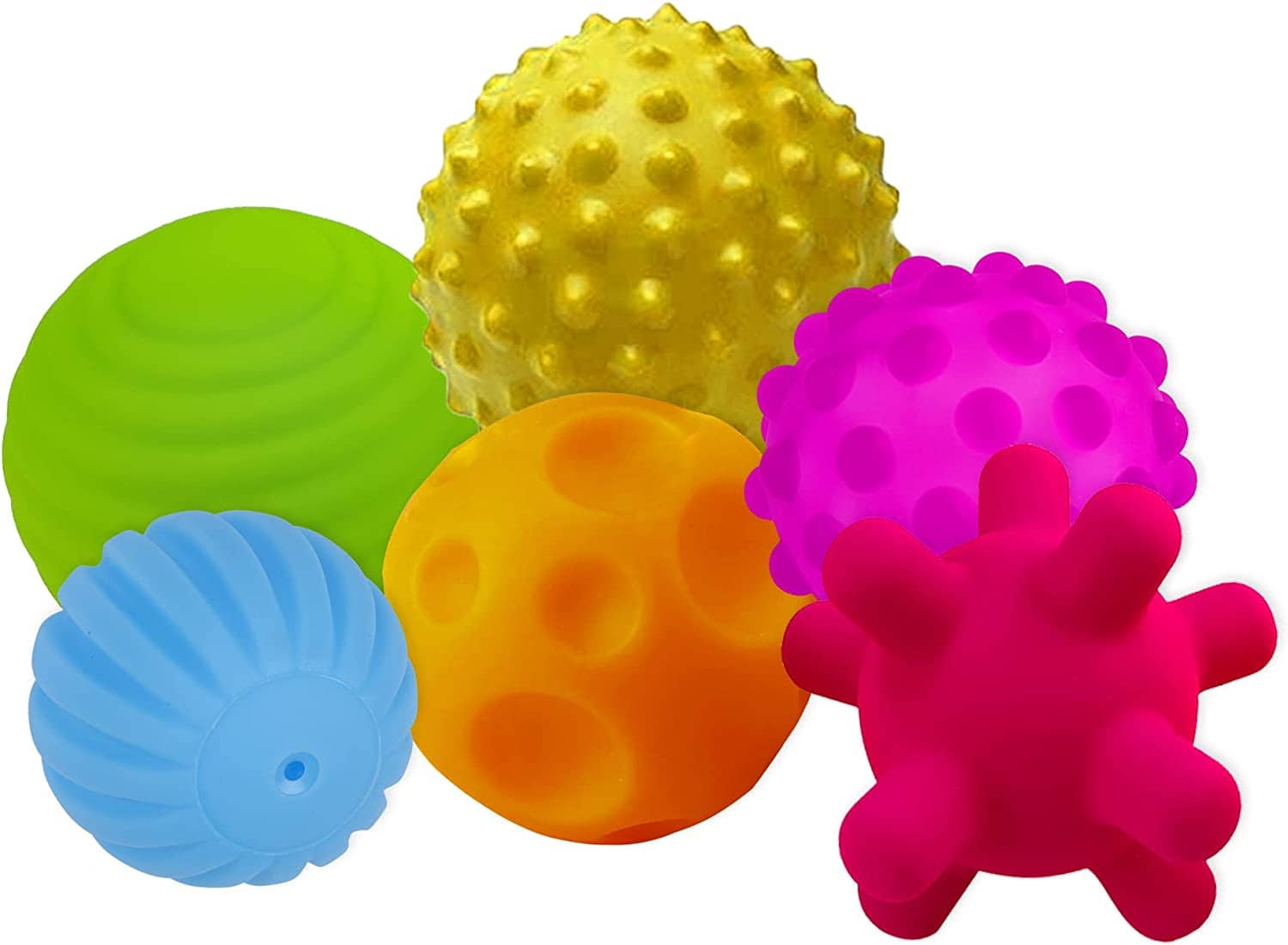
These colorful textured balls feature six colors and textures and can stimulate your baby’s visual and auditory senses and develop your baby’s hand-eye coordination. They also squeak when the baby squeezes them for added cause-and-effect learning.
7. Sensory Shaker Toy

This rattle will engage several of your baby’s senses. The jellyfish responds to your baby’s movements and rewards their curiosity with a color-changing light show and classical melodies. The textured rope “tentacles” are great for engaging a baby’s tactile awareness.
8. Baby Paper

This is, hands down, one of our favorite sensory toys for babies. The outer layer is a strong black and white contrast fabric, perfect for a baby’s vision, and inside is paper that makes a crinkly sound when a baby plays with it, and they’ll love it! It is non-toxic and compact for easy travel; stuff it in your diaper bag to take it on the go. Plus, it’s machine-washable, so your baby can play with it again and again.
9. Peek-a-Boo Sensory Fish

This fish is such a cute toy. Baby will love lifting the scales to reveal the pictures underneath. There are different colors, textures, and even some crinkly paper your baby will love playing with.
10. Dimpl Wobbl

This sensory toy for babies is such a joy to watch. It has a bumpy, sensory texture that your baby will love feeling, and the button at the top is irresistible to push and pop. But the best part is your baby can use it as a teether, and guess what happens when they throw or drop it? It lands upright every time! The weighted bottom allows it to wobble and tilt, but it’ll always land on its feet.
10 Best Sensory Toys for Toddlers
1. Play-Doh

Play-Doh has been around for many years and continues to be a very popular toy, and for a good reason. The texture is excellent for encouraging hands-on, open-ended learning. Your child will love to squish and mold the Play-Doh into different forms and shapes. You can even make homemade playdough. And bonus – it’s a great fine motor activity.
2. Edushape Sensory Balls

The bumpy texture on this ball makes it easy for little hands to grasp and pick up and offers great tactile input for their sense of touch. Tossing and catching a ball is a great gross motor activity that benefits a child’s hand-eye coordination. Playing the same game with a textured ball introduces more sensory components. There are many colors, and some even glow in the dark.
3. Crayola Touch Lights

I love this mess-free portable finger-painting board. It gives great sensory feedback without the mess, so it’s perfect for on-the-go. It’s also great for kids who are maybe a bit aversive to messy hands. The music and lights make for a wonderful multi-sensory experience for your little one.
4. Pop Tubes

We love the tactile and auditory stimulation these provide, and they also incorporate fine motor skill development, bilateral coordination, and cause-and-effect learning. Your kids will love the fun crinkly sound they make when you push them together and pull them apart.
5. Montessori Pull Toy

This is a recent find of mine, and our baby can’t get enough of it. This Montessori toy is another great sensory toy for on-the-go and will hold your little one’s attention for a while. It features different colors and textures, which makes for a great sensory experience, but I also love that it encourages excellent bilateral coordination and fine motor play.
6. Trampoline

Jumping is a great sensory experience that can help a child get some deep proprioceptive input. This sensory input helps our kids learn body awareness skills and motor coordination. It also helps them get some of their wiggles and extra energy out.
7. Scooter Boards
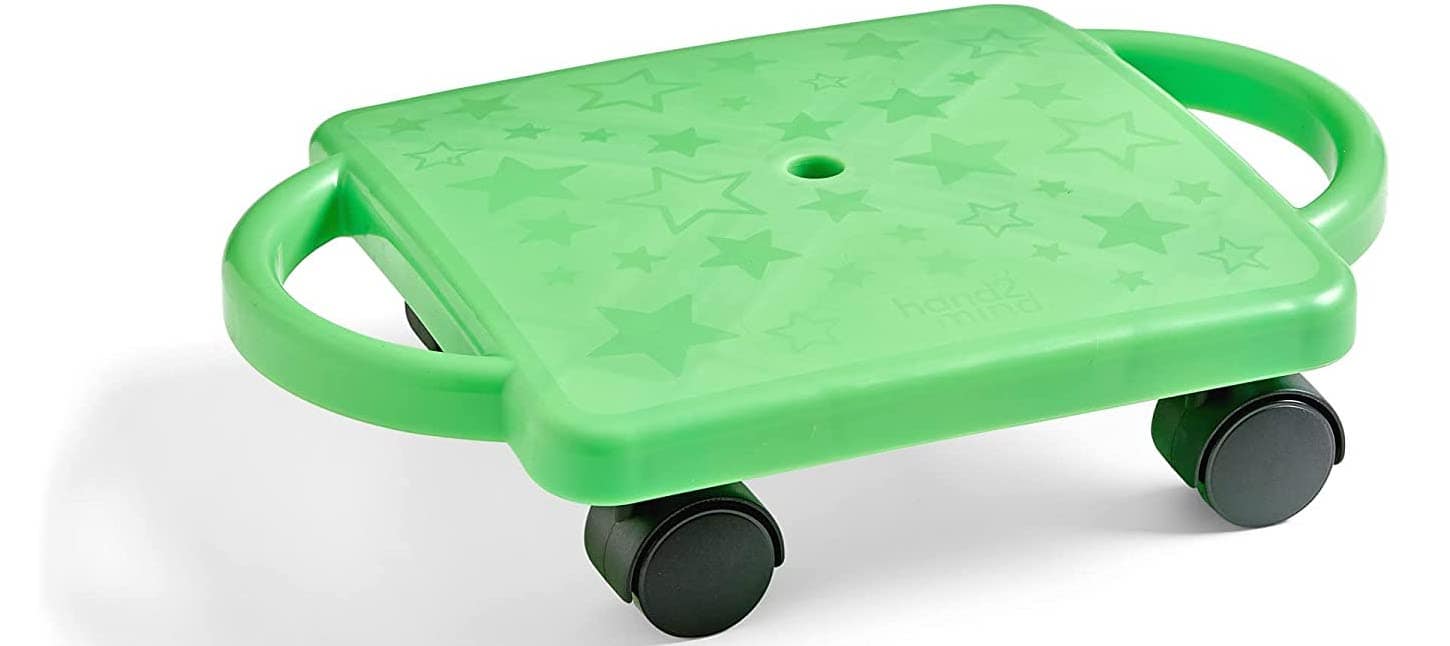
These are great for providing vestibular input but also incorporate building core strength and coordination. The handles keep fingers safe while providing steering and control of the board. One of my favorite ways to use this sensory toy for toddlers is by making a “track” on the floor using painter’s tape and having your child drive along the track using the scooter board. Big kids love this sensory toy too!
8. Sensory Water Beads Bean Bags

Water beads are a great sensory toy and tool for toddlers, and I love these because the water beads are contained and safe but still provide a fun sensory experience for your little one. These feature letters paired with flashcards, so you can start teaching your baby letters and basic words.
9. Activity Cube

Activity cubes are great multi-sensory experiences that help with gross motor development. Most activity cubes provide a stable base for babies to begin pulling up to stand. They also allow your little one to begin engaging in independent play. Encouraging independent play will be very useful as your baby grows because, as parents, we can’t entertain a baby every second of every day. Toys like this are ideal since they’re safe and engaging. All the little peek-a-boo doors and manipulatives are wonderful. There’s so much for your baby to explore, so they will surely be entertained for a good chunk of time.
10. Food
Yes, food. Food is a great sensory activity for kids. Some of my favorites are foods like Jell-O, yogurt, uncooked rice, and cooked spaghetti noodles. You can put any of those foods in a large baking dish or tray, place various toys inside, and let your toddler play until their heart’s content. I always like using food dye in the yogurt and allowing our children to use paintbrushes to swirl the colors around for fun color mixing. You can also dye rice or spaghetti noodles. Using food is a great way to introduce open-ended sensory play because it is a taste-safe learning experience (if you’re not using anything that is a choking hazard or allergens your child is sensitive to). And honestly, with toddlers, taste-safe is a big win!
10 Best Sensory Toys for Kids
1. Kinetic Sand

The texture of this sand is somewhere between sand and Play-Doh, and kids LOVE it! They can mold it into all kinds of shapes and figures. I also like pouring it into a tray and having them use their finger for writing letters and numbers. Tactile learning can help kids retain proper letter and number formation more than just tracing or copying with a pencil or crayon.
2. Foam Sensory Paint

Arts and crafts time is a great way to work on fine motor skills and bilateral coordination, and I love introducing a sensory component to it with something like foam paint. You can have your kids finger paint in the foam, but the texture is airier than standard finger paint, so it’s an entirely different sensory experience.
3. Shaving Cream
Shaving cream is another great texture that your kids might love. An easy way to have them play with shaving cream is in the bath or shower. We call these “shaving cream baths,” and our kids love them. They can spray the shaving cream all over the walls, use their fingers to write or draw in it, and then spread it around to “erase” their drawings and start over again. And when they’re finished, you can rinse it off the walls and give the kids a bath for easy clean-up.
4. Swing
Swings provide excellent vestibular input for kids, which helps them better understand movement and their head position in space. Take your kids to the park for playtime on the swings, or put up a swing in your backyard. Swings that move in a forward/backward motion are great but also consider swings that can turn and provide rotary movement for your kids.
5. Sensory Activity Table
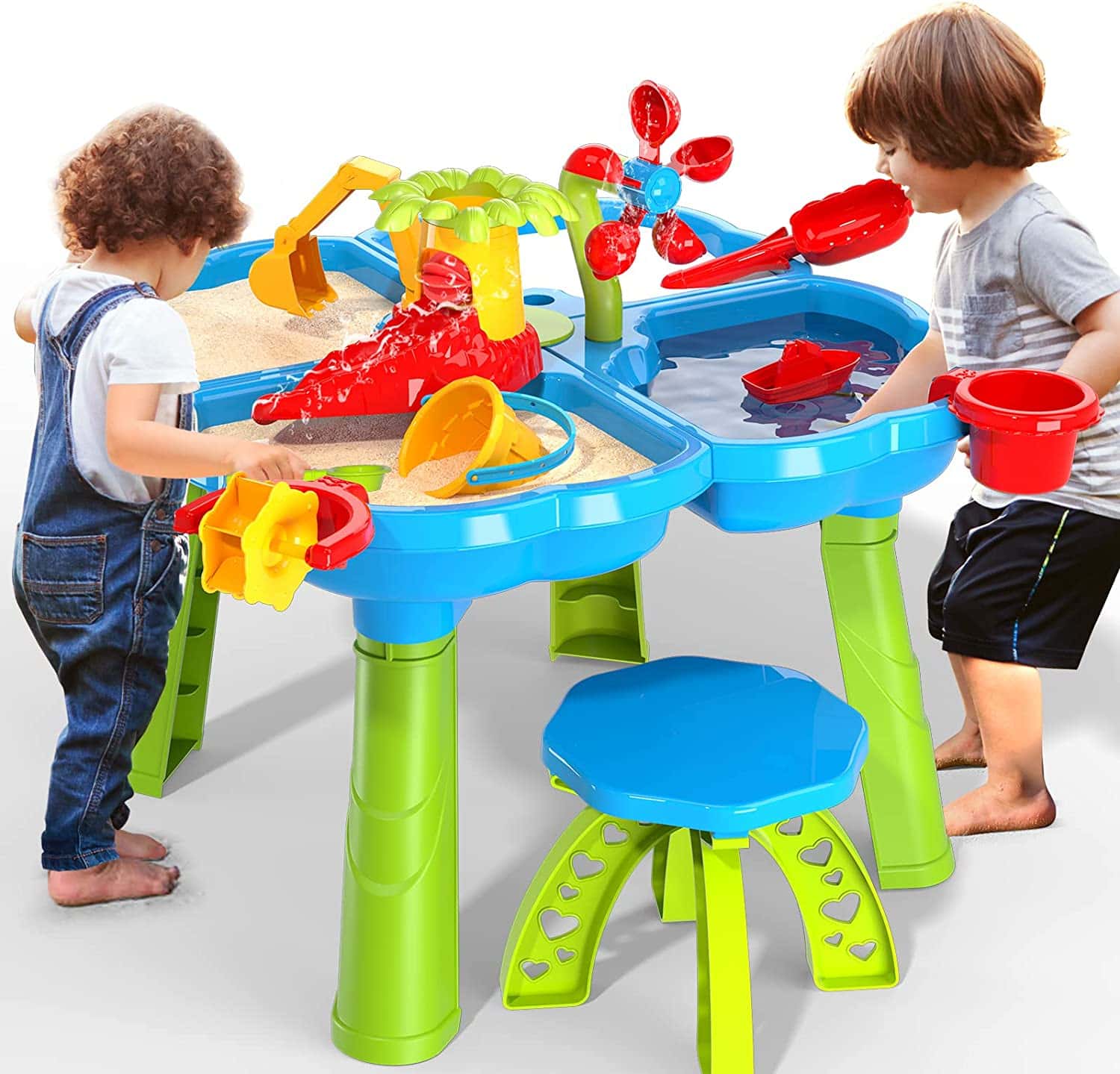
All kinds of sensory tables are available for kids and provide endless possibilities. I love using them as a mini sandbox or water table, or you could even use them as a shaving cream bin. They are available at various prices, with some options featuring a drain for easy clean-up.
6. Wikki Stix

Kids can use these wax sticks to create all kinds of creations. They can mold them together to make a sculpture or use them to form letters and numbers. They can stick them onto smooth surfaces without glue, making them a great mess-free play option. I love the tactile input these provide and the fine motor coordination used to mold them together.
7. Balance Beam
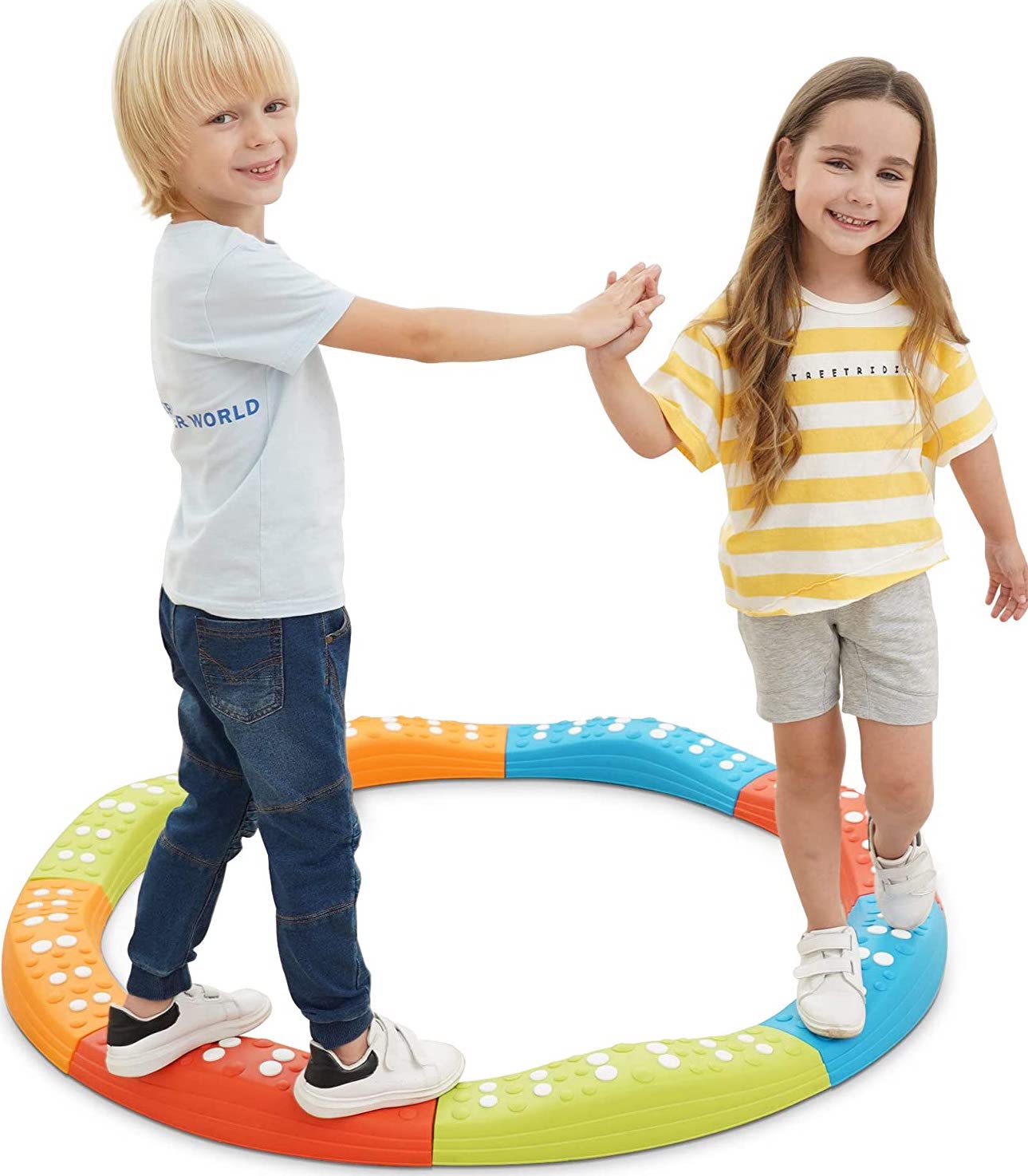
A balance beam is great for working on dynamic balance and core strength. They also help your child learn about body awareness (where their body is in space). I love creating obstacle courses with a balance beam, cushions to climb over, and a crash pad (or pillows) to jump into.
8. Teeter Popper

Balance boards are great for working on core strength, stability, leg strength, balance, coordination, and gross motor skills. But the Teeter Popper also has small suction cups on the bottom, so whether they’re sitting or standing on the balance board, they are rewarded with popping sounds as they move. This one is a blast!
9. Water Rings Game
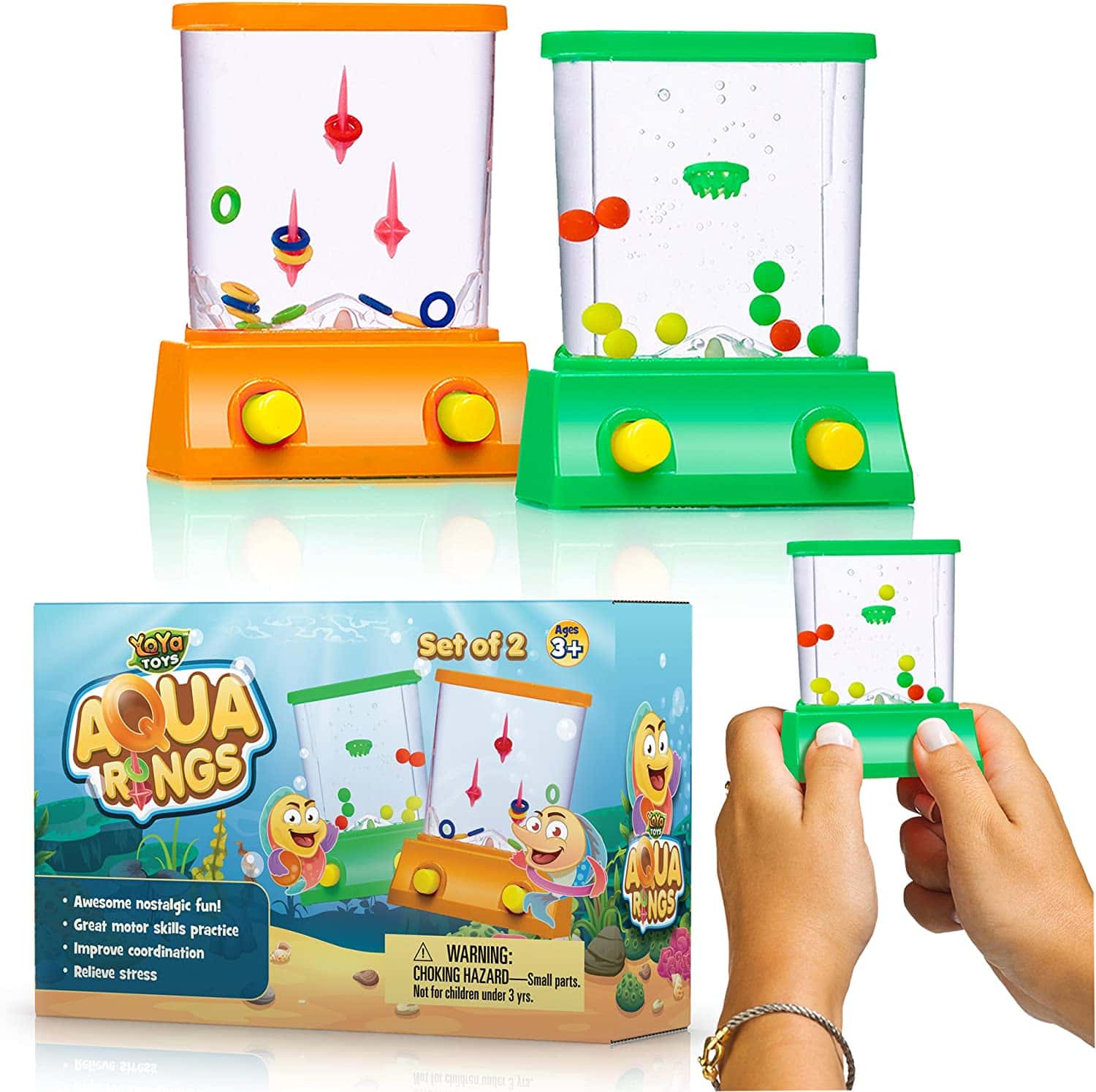
These games will keep your child occupied while helping them develop hand-eye coordination and fine motor skills. The way the rings float around in the water provides calming visual input too. These are great alternatives to screen time and video games.
10. Sensory Fidget Tubes

I love these calm-down tubes for times when kids are feeling angry or upset. They provide visual cues for calming down their bodies, and they’re great for helping teach kids how to regulate their emotions.
There are countless ways to incorporate sensory play into your child’s day, and it has many incredible benefits for their development. In addition to these sensory toys for babies, toddlers, and kids, you can look online for DIY sensory play ideas. Encouraging your child to engage in hands-on sensory play benefits their motor, language, cognitive, and social-emotional development. Play of all kinds is essential in helping your child develop the necessary skills to navigate the world independently. They’re working on all of these skills without even knowing it. They think they’re “just” playing, but we know the real purpose of play. Don’t worry – I won’t tell them the secret. Happy playing!

